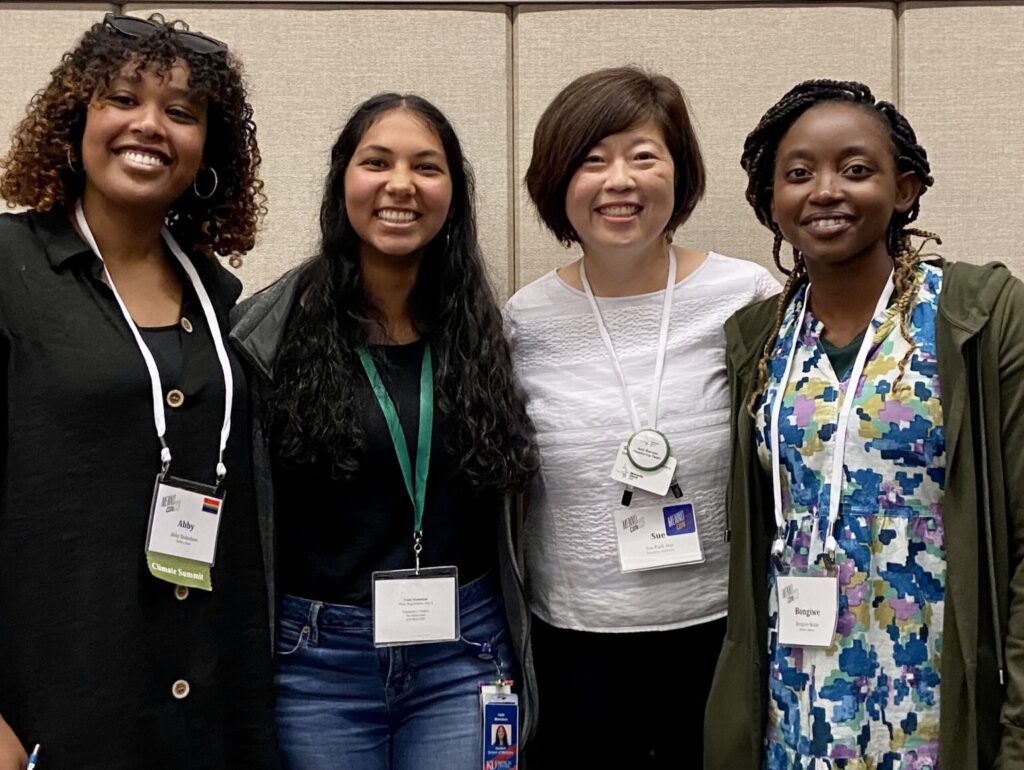Written by Mennonite Church USA staff and originally published by MC USA
Tips on creating an intercultural campus culture

A panel of BIPOC young adults shared their experiences attending Christian/Mennonite schools in a seminar on July 6, 2023, at MennoCon23, Mennonite Church USA’s nationwide convention in Kansas City, Missouri. Sue Park-Hur, Mennonite Church USA’s director of racial/ethnic engagement, moderated the panel.
Panelists Abby Endashaw, Mennonite Central Committee Summer Service National Coordinator; Faith Manickam, [alum of Eastern Mennonite University, Harrisonburg, Vir.]University of Kansas School of Medicine student, and Bongiwe Ncube, Goshen (Indiana) College student shared positive and painful moments and offered tips to students and administrators for building a healthy intercultural campus culture.
As they introduced themselves, the panelists acknowledged their intersectionality and their various cultural identities, encompassing race, ethnicity, gender, religious background and more.
“I am a person of color. I am also Anabaptist. I had the experience of being a third-culture kid, and I am mixed race,” said Manickam. “Each of these pieces represents a different part of me,” she explained.
Endashaw described herself as protestant and Ethiopian Christian. “These are things that influence the way that I experience my faith, my God and the world.”
“In America, we’ve become so polarized that it’s white people and BIPOC, and we have assumptions about each other. But there are so many complexities in our identities,” said Park-Hur.
She then asked the panel to describe a time when they felt included. Affinity groups played a large role in making the students feel welcome.
“The International Student Club [at Goshen] holds an annual event called the coffeehouse,” said Ncube. “This event provides a platform for both international students and domestic students to share aspects of their culture through music, dance and sometimes spoken word. I’ve had the privilege of participating in this event,” she said. She also mentioned a time when she was invited to submit an article to the college newspaper.
“I think that’s very important to have BIPOC students speak for themselves to the wider audience, rather than speaking about BIPOC students,” Ncube said.
“Big things for me were having friends who were curious and wanted to ask questions about my experiences,” said Manickam. “They’d say, ‘Hey, we really want you to make a Thai meal for us. Can you tell us what the ingredients are? We will get them and let’s have an evening and cook together.”
Endashaw said she felt a sense of belonging when she saw a prayer board in a dorm. “The girls had written prayer requests and ways that they were supporting each other.”
The panelists shared other ways that students can help to create an intercultural campus.
- Have cultural humility. Be open to experiencing and learning new things.
- Seek out organized spaces where you can go to meet people to have conversations that challenge your viewpoints.
- Be intentional about being kind to one another. “When I first came into the U.S., which was three years ago, I noticed that people tended to look away when they passed me in the hallway,” said Ncube. “I thought, ‘Is this like a cold culture or what’s going on?’ I realized people were just avoiding. But something as simple as greeting someone has power. If you can do that consistently, it also does something to you, as well. It leaves you with a sense of self respect,” she said.
“Sit next to [BIPOC] people in classes,” suggests Manickam. “Don’t just sit in your own corner. It’s really easy to sit next to someone new.”
- Have empathy for international students, who deal with added stresses and burdens, such as visas and various rules and requirements that U.S.-born students don’t need to worry about.
- Don’t be hypocritical in your support of BIPOC organizations. Ncube referred to this as “fake activism.” She provided the example of a person who might wear Black Lives Matter paraphernalia but is unwilling to share space with a Black person.
- Don’t be offended or put off when all the BIPOC or international students sit together or eat lunch together. Endashaw encouraged students, especially ones who feel comfortable in that space, to respond with empathy, by recognizing that this one hour when the BIPOC students are sitting with their other BIPOC friends is their one hour of rest in the day.
- Be intentional about inviting your BIPOC friends to join in. “If there are [BIPOC] students who are hanging out with your group, invite them when you go out places,” suggests Manickam. “Don’t leave it as something where it’s like, ‘Oh, anyone can join.’ Make an effort and give an invitation. That means a lot,” she said.
- Be hospitable. Invite your international friends to visit with you, especially over the holidays, as they may not have the opportunity to return home to their families. Endashaw shared a painful story about attending church on Easter and hoping for an invitation that never came. “I spent another Easter alone and sad,” she said.
Lindy Feaster, a youth attendee from Shalom Mennonite Church in Tucson, Arizona, said she found the suggestions helpful, especially the reminders to be aware when someone isn’t being included. “I think that’s super important because you can get so caught up. I’ve been so happy to be around other Mennonite people [this week], but it’s important to think, is there somebody here who is not happy? Or who is not being included? And how can I help them? I think that is at the core of Christianity and of Anabaptism. It’s extending that peace to others and approaching new friends with curiosity.”
Endashaw recommended several resources for students, including the book, “Why are all the Black Kids Sitting Together in the Cafeteria,” by Beverly Daniel Tatum.
“I also would recommend the Intercultural Development Inventory or IDI. It’s an assessment that you can take to learn more about yourself and how you can grow. It gives you a roadmap about how you can connect with greater intercultural competence to a broader range of people,” she said.
“Part of being Anabaptist means acknowledging the presence of interracial … discomforts,” said Ncube. She explained that peacemaking means, “understanding the reasons for that lack of peace, making an honest assessment of what one can do to work toward peace, and then working consistently toward achieving that peace and maintaining it.
“Working toward that peace is not, I believe, a revolutionary process,” said Ncube. “It’s an evolutionary process. We shouldn’t expect change immediately. It’s a process that we should be patient with.”
Park-Hur summarized the seminar, saying, “You all have power. You all have the power to create an intercultural culture within your rooms, your dorms, and your classes.”
For more information on the IDI assessment, contact Sue Park-Hur at SPHur@Mennoniteusa.org.

